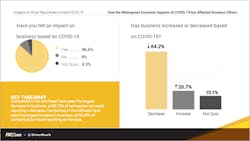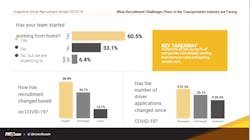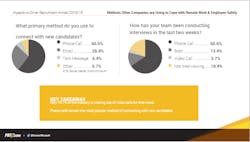COVID-19 could be a good time to find quality drivers if you know how to look
Almost every trucking fleet is feeling the impacts of COVID-19 — some good but most bad — as the industry deals with the economic impacts of a pandemic that has closed businesses and pushed much of America indoors. While many lives are being disrupted, many fleets are keeping supply chains moving and still seeking out new drivers in this new world.
Right now might be the right time to seek out high-quality drivers as most fleets have decreased recruitment advertising and some have put out a hiring freeze. On the driver side, some drivers may be taking this opportunity to seek out employment with fleets that are more driver-centric. How fleets use technology to connect with drivers could be the difference for carriers looking to hire top-notch drivers in 2020.
Jeremy Reymer, DriverReach founder and CEO, hosted a webinar April 21 on how COVID-19 is affecting the driver recruitment process. He noted that how fleets protect and focus on drivers, particularly during a pandemic, goes a long way. “The concerns drivers have during this health crisis, to me, need to be at the forefront of your thought process,” he said. “Make sure they have the tools, safety, and equipment they need.”
COVID-19 business impact
Nearly 40% of driver recruitment leaders said their fleet’s loss in business has been the biggest challenge of the pandemic, according to a survey in mid-April by FATj.com. The third biggest impact on the list — behind managing the supply chain (28.1%) — was hiring new employees (18.4%). The same survey found that more than half of fleets have had drivers stop driving due to COVID-19 fears, meaning many fleets are still looking for new drivers to fill gaps.
FATj.com, the Find A Trucker Job platform, surveyed more than 300 driver recruitment leaders at carriers across the U.S. to get a pulse on the driver hiring market during the pandemic. “I think it’s really helpful for all of us as we try to learn more and get a grasp on the situation that we’re dealing with right now, which is, for all of us, unique and hopefully a one-time circumstance as far as everything is concerned,” Alex McKeown, the FATj.com CEO, said during the webinar.
Almost nine out of 10 respondents said their business has felt some sort of impact from COVID-19, according to the survey. The virus has decreased business for 65.2% of respondents while 20.7% reported an increase.
Small fleets have been hit hardest by COVID-19 while some larger fleets have seen more business growth since the pandemic began. Nearly three-quarters of fleets with 10 or fewer trucks reported a decrease in business due to the new coronavirus, the survey stated. Nearly a third of large fleets — with at least 500 trucks — reported business growth during the pandemic.
Roughly nine in 10 companies in the Northeast saw a decrease in business since coronavirus concerns began, according to the survey. And more companies in the Midwest than any other region reported an increase in business — albeit only 28.4% of them.
Optimism for the transportation market is mediocre, according to the FATj.com survey. Nearly half (49.2%) of those surveyed rated their optimism of the market as a three out of five. A quarter of respondents rated it at one or two. The other quarter rated it at four or five. The bus and motorcoach segment has the lowest optimism for the market (2.42 average) while the building materials segment has the highest (3.47).
Almost all recruiters surveyed expect COVID-19 to affect their businesses into the second half of 2020 — with only 7% expecting it to last a month. Fifty-seven percent expect the pandemic-effect to last at least four months. More than 20% expect it to last at least six months to more than a year.
Finding new drivers during a pandemic
Even with the pandemic impact on fleets, recruitment budgets have not been decreasing at the same rate as business profits, according to McKeown. The survey also shows that 54% of fleets have had drivers stop driving due to COVID-19 fears.
“And obviously, that becomes an issue in an industry that's always already challenged in terms of being able to hire and being able to find qualified candidates,” McKeown said. “Losing qualified drivers who may have been driving and have had great safety records with the organization for years is a real challenge, and having to fill that spot is a challenge for recruiters and, of course, unexpected.”
The already challenging market of driver hiring has gotten even harder because of COVID-19, according to more than half of the survey respondents, a plurality of whom (41.5%) said they’ve seen driver applications decrease during the pandemic. A quarter of respondents said they’ve seen an increase in applications this spring while a third have seen no change.
“Professional truck drivers, just in terms of supply and demand metrics, are in short supply, and, as such, it costs a lot to go out and find drivers who aren't already within your ecosystem that you can market and remarket to,” McKeown said.
Now might be a good time to increase recruitment advertising if you need drivers, McKeown added, because there is less competition as most fleets have pulled back on advertising. He said FATj.com has seen an uptick in the quality of applicants based on an internal metric. With less competition in the marketplace for drivers, McKeown said his firm is finding more success for those companies that are actively seeking new drivers.
Jeremy Reymer, CEO of DriverReach, found it interesting to see the level of engagement by driver applicants right now. “It's intentional versus they might fill out some apps because maybe they just had a bad day, and they're just gonna fill it out and see what's out there; do some fishing,” he said. “But this is a little different. It sounds like it's more intentional and deliberate.”
How fleets respond to applicants can play a big role, too. High-tech communication such as video calls is yet to become the norm for driver interviews, according to the survey. Most recruiters (65.6%) are relying on the phone to talk with prospective new employees. Just 2.7% or using video conferencing while 13.4% are using both phone and video. Nearly one out of five survey respondents said they are not interviewing.
The phone is also the way that first connections with candidates are being made by 60.5% of the fleets surveyed. A little more than a quarter (26.4%) are using email; 6.4% are using text messages; and 6.7% are relying on other ways such as social media and word of mouth.
McKeown said video conferencing can be a great way to show a potential new hire you are interested. “It shows them that you’re not answering five emails while you’re running them through a list of interview questions,” he said. “It shows that you really care about their time and you’re valuing it. And it’s giving them the best start for their experience as they go through the interview, recruiting, hiring and training process with your company.”
Reymer added that video meetings are the next best thing to in-person interviews with drivers when it comes to showing engagement and empathy.
McKeown said he was surprised the survey results showed that more than a third of recruiters (36.1%) aren’t using social media to find drivers. The most popular social media platform for driver recruitment is Facebook (46.2%) while others such as LinkedIn, Twitter and Instagram were lightly used.
“Social media is a really good avenue,” he pointed out. “Drivers are very active on social media — especially Facebook, not so much LinkedIn. So Facebook is one really good source… A social media recruiting strategy is something you want to evaluate as a big opportunity moving forward.”
About the Author
Josh Fisher
Editor-in-Chief
Editor-in-Chief Josh Fisher has been with FleetOwner since 2017. He covers everything from modern fleet management to operational efficiency, artificial intelligence, autonomous trucking, alternative fuels and powertrains, regulations, and emerging transportation technology. Based in Maryland, he writes the Lane Shift Ahead column about the changing North American transportation landscape.






